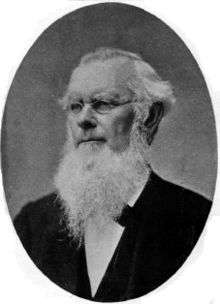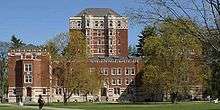Milo Parker Jewett
Milo Parker Jewett (27 April 1808 – 9 June 1882) was the first president of Vassar College, holding the office from 1861 to 1864.
Milo Parker Jewett | |
|---|---|
 Jewett circa 1860-1870 | |
| 1st President of Vassar College | |
| In office 1861–1864 | |
| Succeeded by | John Howard Raymond |
| 1st President of Judson College | |
| In office 1838–1855 | |
| Succeeded by | Archibald John Battle |
| Personal details | |
| Born | 27 April 1808 St. Johnsbury, Vermont, US |
| Died | June 9, 1882 (aged 74) Milwaukee, Wisconsin |
| Education | |
| Profession | Educator, college president |

Biography
Born in St. Johnsbury, Vermont, on 27 April 1808, Jewett was a graduate of Dartmouth College (1828) and Andover Theological Seminary (1833).
He became a professor of rhetoric and political economy Marietta College, resigning in 1838 after adopting Baptist tenets.
He founded Judson College in 1838 and served as president until 1855. He established Vassar College with Matthew Vassar in February 1861, serving as president until 1864,[1] when he resigned from office following a disagreement with Vassar.[1]
In 1867 he moved to Milwaukee, Wisconsin, where he died on 9 June 1882.
Legacy
The Milo Jewett House at Vassar is named after him in honor of both his promotion of female education and his service to the college.
Publications
- Baptism (1840)
- Education in Europe (1863)
- Relations of Boards of Health and Intemperance (1874)
- The Model Academy (1875)
References
- Van Lengen, Karen; Reilly, Lisa (2004). The Campus Guide: Vassar College. New York City: Princeton Architectural Press. pp. 4–10. ISBN 1-56898-349-2.
- This article incorporates text from a publication now in the public domain: Gilman, D. C.; Peck, H. T.; Colby, F. M., eds. (1905). New International Encyclopedia (1st ed.). New York: Dodd, Mead. Missing or empty
|title=(help)